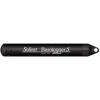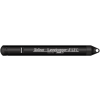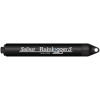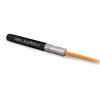Solinst Levelogger 5 Water Level Loggers
Features
- Single-eye optical interface - easier to clean, more scratch-resistant
- Increased memory: 150,000 sets of data
- Double o-ring seals for increased leakage protection
- Free ground shipping
- Expedited repair and warranty service
- Lifetime technical support
- More
Multiparameter Testing
The Solinst Levelogger 5 combines a pressure sensor, temperature detector, 10-year lithium battery, and datalogger, sealed within a 22mm x 160mm (7/8" x 6.3") stainless steel housing with a PFAS-Free corrosion-resistant coating baked-on using polymerization technology.
Hastelloy Pressure Sensor
The Levelogger 5 measures absolute pressure using a Hastelloy pressure sensor and offers high resolution and an accuracy of 0.05% FS. Readings are stable in extreme pressure and temperature conditions. The Hastelloy sensor can withstand 2 times over-pressure without permanent damage. Combined with the durable coating inside and out, the Levelogger 5 has high corrosion and abrasion resistance in harsh environments.
Protective Design
The logger uses a Faraday cage design, which protects against power surges or electrical spikes caused by lightning. Its durable maintenance-free design, high accuracy and stability, make the Levelogger 5 the most reliable instrument for long-term, continuous water level recording.
Level Sensor: Piezoresistive Silicon with Hastelloy Sensor
Accuracy: ± 0.05% FS (Barologger 5: ± 0.05 kPa)
Stability of Readings: Superior, low noise
Resolution: 0.002% FS to 0.0006% FS
Units of Measure: m, cm, ft., psi, kPa, bar, ºC. ºF (Barologger 5: psi, kPa, mbar, ºC, ºF)
Normalization: Automatic Temperature Compensation
Temp. Comp. Range: 0º to 50ºC (Barologger 5: -10 to +50ºC)
Temperature Sensor: Platinum Resistance Temperature Detector (RTD)
Temp. Sensor Accuracy: ± 0.05ºC
Temp. Sensor Resolution: 0.003°C
Battery Life: 10 Years – based on 1 reading/minute
Clock Accuracy (typical): ± 1 minute/year (-20ºC to 80ºC)
Operating Temperature: -20ºC to 80ºC
Maximum # Readings: 150,000 sets of readings
Memory Mode: Slate and Continuous
Communication: Optical high-speed: USB, SDI-12 57,600 bps with USB
Size: 22 mm x 160 mm (7/8" x 6.3")
Weight: 146 grams (5.2 oz)
Corrosion Resistance: Baked-on coating using polymerization technology (inside and out)
Other Wetted Materials: Delrin®, Viton®, 316L stainless steel, Hastelloy, PFAS-free PTFE coating
Sampling Modes: Linear, Event & User-Selectable with Repeat Mode, Future Start, Future Stop, Real-Time View
Measurement Rates: 1/8 sec to 99 hrs
Barometric Compensation: Software Wizard and one Barologger 5 in local area (approx. 30 km/20 miles radius)
In The News
2025 Essential Water Monitoring Gear
Stay ahead of the curve with five of the top water monitoring products for 2025. Technological advancements and manufacturing innovations are leading to better quality data, improved price points, and enhanced user experience. And, while the ‘essentials’ list includes several new products, two tried-and-true measurement instruments continue to take a top spot for portable instrumentation. These five products were developed by industry-leading suppliers, and in addition to extensive manufacturer testing, our science team tested and verified each instrument’s performance at the Fondriest Center for Environmental Studies .
Read MoreCarbon and Nutrient Monitoring in the Great Lakes Using Satellite Observations
Carbon and nutrients are the foundation of lake food webs and play an important role in the chemical and physical processes that shape aquatic ecosystems and various lake dynamics. Studying these cornerstones can help improve understanding of other lake conditions like harmful algal blooms, hypoxia, and phytoplankton community composition. The way in which these characteristics are monitored varies, though many rely on a proxy approach wherein parameters are extrapolated from the measurement of a different parameter. An assistant professor at Cleveland State University, Brice Grunert, is working to improve current strategies and take a satellite approach to monitoring the Great Lakes.
Read MoreRestoring North Texas Streams to Historical Flows
North Texas is one of the fastest-growing regions in the state, an area that is expected to face increasing water needs. In order to meet these demands, the Upper Trinity Regional Water District ( UTRWD ) is building Lake Ralph Hall near Ladonia in southeast Fannin County, Texas. The lake has been in the works since 2003, with construction finally beginning in 2021. The population of the UTRWD is expected to grow 5-fold over the next 50 years, leading to increased water use. Ed Motley, Program Manager with the UTRWD stresses that even with conservation and reuse, new sources like Lake Ralph Hall are essential to meeting near-term and long-term water needs to support regional growth.
Read More



























































